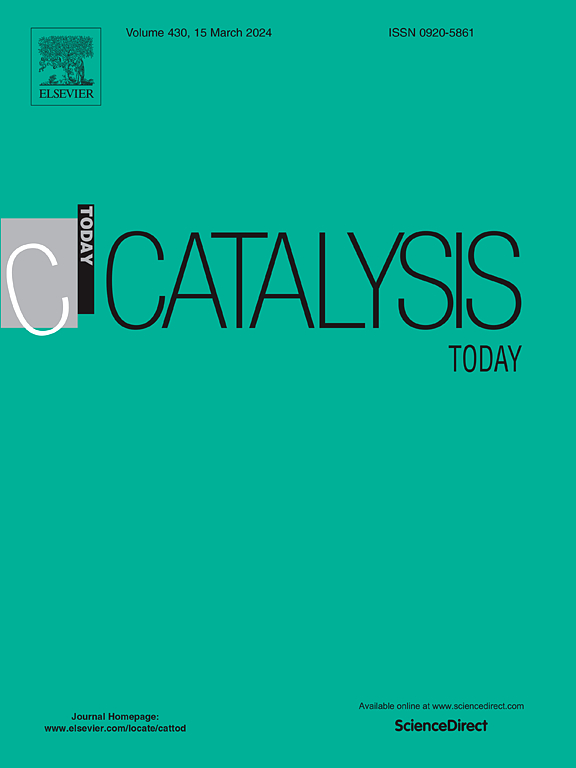Ethane ODH with CO2 over alumina-supported Fe-Ni-O mixed oxides catalysts
IF 5.3
2区 化学
Q1 CHEMISTRY, APPLIED
引用次数: 0
Abstract
The dehydrogenation of ethane in the presence of CO2 on alumina supported Fe-Ni-O catalysts was studied. The Fe/Ni ratio in catalysts strongly influences both the conversion of ethane and CO2 and the nature of reaction products. Iron species, linked to the hematite phase (α-Fe3O4), favors ethane ODH but also the RWGS and dry reforming reactions (as parallel reactions). Nickel oxide has a high catalytic activity due to its capacity to break both C-H and C![]() C bonds in a non-selective way, facilitating the generation of CO. Characterization results show changes in catalysts during the reaction. The H2-TPR patterns of catalysts suggest a low interaction between the support and the iron particles, and a parallelism between the reducibility of iron particles and the conversion of reactants. In addition, all catalysts suffer important restructuration under reaction conditions, with iron oxide segregates to the catalyst surface together with a partial reduction of Fe3+ to Fe2+ (as determined by XPS). These changes could be confirmed by XRD, Raman, XPS and UV–vis spectroscopy analyses. Temperature programmed surface reactions (TPSR), under different experimental conditions, indicate an important role of nickel in the bimetallic catalysts, avoiding severe reduction of the catalyst and stabilizing different types of iron oxide species with different selectivity to products.
C bonds in a non-selective way, facilitating the generation of CO. Characterization results show changes in catalysts during the reaction. The H2-TPR patterns of catalysts suggest a low interaction between the support and the iron particles, and a parallelism between the reducibility of iron particles and the conversion of reactants. In addition, all catalysts suffer important restructuration under reaction conditions, with iron oxide segregates to the catalyst surface together with a partial reduction of Fe3+ to Fe2+ (as determined by XPS). These changes could be confirmed by XRD, Raman, XPS and UV–vis spectroscopy analyses. Temperature programmed surface reactions (TPSR), under different experimental conditions, indicate an important role of nickel in the bimetallic catalysts, avoiding severe reduction of the catalyst and stabilizing different types of iron oxide species with different selectivity to products.
乙烷ODH与CO2在氧化铝负载的Fe-Ni-O混合氧化物催化剂上的反应
研究了氧化铝负载的Fe-Ni-O催化剂上乙烷在CO2存在下的脱氢反应。催化剂中Fe/Ni的比例对乙烷和CO2的转化以及反应产物的性质都有很大的影响。铁与赤铁矿相(α-Fe3O4)相连接,有利于乙烷ODH反应,也有利于RWGS反应和干重整反应(作为平行反应)。氧化镍具有很高的催化活性,因为它能够非选择性地破坏C-H和CC键,促进CO的生成。表征结果显示了反应过程中催化剂的变化。催化剂的H2-TPR模式表明载体与铁颗粒之间的相互作用较低,铁颗粒的还原性与反应物的转化之间存在平行关系。此外,所有催化剂在反应条件下都发生了重要的结构调整,氧化铁偏析到催化剂表面,同时Fe3+部分还原为Fe2+(由XPS测定)。这些变化可以通过XRD, Raman, XPS和UV-vis光谱分析来证实。在不同的实验条件下,温度程序表面反应(TPSR)表明镍在双金属催化剂中的重要作用,避免了催化剂的严重还原,并稳定了不同类型的氧化铁对产物的不同选择性。
本文章由计算机程序翻译,如有差异,请以英文原文为准。
求助全文
约1分钟内获得全文
求助全文
来源期刊

Catalysis Today
化学-工程:化工
CiteScore
11.50
自引率
3.80%
发文量
573
审稿时长
2.9 months
期刊介绍:
Catalysis Today focuses on the rapid publication of original invited papers devoted to currently important topics in catalysis and related subjects. The journal only publishes special issues (Proposing a Catalysis Today Special Issue), each of which is supervised by Guest Editors who recruit individual papers and oversee the peer review process. Catalysis Today offers researchers in the field of catalysis in-depth overviews of topical issues.
Both fundamental and applied aspects of catalysis are covered. Subjects such as catalysis of immobilized organometallic and biocatalytic systems are welcome. Subjects related to catalysis such as experimental techniques, adsorption, process technology, synthesis, in situ characterization, computational, theoretical modeling, imaging and others are included if there is a clear relationship to catalysis.
 求助内容:
求助内容: 应助结果提醒方式:
应助结果提醒方式:


